Microstructure is important to the performance and characteristics of pharmaceuticals, medical devices and pharmaceutical packaging in many different ways. For example, particle size, shape and packing all play a part in the dissolution of tablets. The coverage and thickness of a coating helps to determine the stability of a capsule, and can also affect its dissolution properties. Microstructure generally determines the flexibility of plastics and of composites assembled from them, and hence the performance of packaging, the integrity of seals, or the performance of components in medical devices. The internal structure of a delivery device will clearly affect how well the dose is targeted, particularly if internal kinks or defects in tubes or needles create blockages or other obstructions to flow, or indeed result in leakage.
Clearly, given that microstructure contributes to optimum performance, microstructural defects are often the root cause of a product’s poor performance or outright failure.
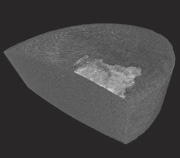
Figure 1: Example of a tablet with metal foreign material at the surface (above), tablet rendered transparent with denser contaminated region coloured in red to demonstrate the absence of interior contamination (below)
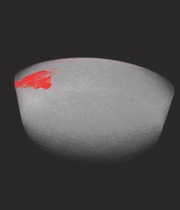
From particle sizers to powder flow analysers and from microscopes to moisture analysers there is a diverse range of technology that can be brought to bear on the investigation of microstructure and/or particles within products. All of these are extremely useful, but do have the drawback that they are in some way destructive. Given the ‘closed’ nature of most pharmaceutical products, it is frequently not ideal for this to be the case. Indeed, in almost every case the ‘perfect’ analytical solution would be non-destructive, allowing the key parameters of the product to be measured in as near intact state as possible.
For example, in the case of a contaminant, it is one thing to be able to extract, isolate and identify a foreign particle that is compromising the performance of a medical device; but it is more useful still to be able to say where the contaminant is within the device and perhaps, by inspecting several devices from the same production batch, to identify that the metal swarf, which was first identified after it was found within some plastic tubing, actually originated from a specific component of a multi-component device.
This ability to examine microstructural features without destroying or disturbing the sample is afforded by X-ray microtomography, an emerging technology made more accessible and powerful by continuing advances in computer technology. It is now proving its worth in new product development, product troubleshooting and foreign material investigations.
How it works
X-ray microtomography is a non-destructive technique that is already familiar to many of us through its application in medical imaging. The hospital CAT scanner is essentially the same technology, creating three dimensional (3-D) images of the patient’s internal anatomy to help physicians in diagnosis, without the need for invasive surgery.
The laboratory’s high resolution X-ray CT (computed tomography) differs from conventional medical CAT scanning in its ability to resolve details down to a few tens of micrometres. The medical CAT scan has a much lower resolution (though it will accommodate a much larger sample).

Figure 2: Light microscope image of tablet with surface coating (above), image of a section through a false coloured tablet reconstruction, revealing the coating thickness and distribution of active and excipient material (below)
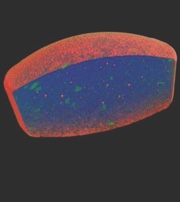
Both technologies involve taking a sequential set of X-ray images of a sample. A specialised algorithm is then applied to these sections to create a 3-D representation of the sample within the computer. By stacking many thin sections, the technique can recreate the fine detail for the whole of a sample’s internal and external microstructural features. The thickness of each section gives rise to the idea that the CT image is composed of voxels (volume elements) rather than the pixels (picture elements) that describe 2-D images.
As will be obvious from its name, the technique involves exposing a sample to X-rays, which are attenuated, i.e. scattered or absorbed by the sample. X-ray attenuation is primarily a function of the incident X-ray energy, density and atomic number of the material being imaged. Hence X-ray tomography can provide imagery and data reflecting both the structure of the material and the atomic mass distribution.
Some of the information gained by X-ray microtomography might also be gained by high resolution scanning electron microscopy (SEM). However, where X-ray microtomography scores over the SEM is in its ability to probe the interior of the whole sample rather than just its surface. To do this using microscopy it is first necessary to mechanically slice the sample into thin sections, which is destructive. Such slicing, known as microtomy, is liable to produce artefactual distortions as a consequence of a usually lengthy preparation technique. It ultimately relies on the skill of the microscopist to infer from a few images what is going on with the whole sample.
X-ray microtomography is much better at presenting a clear picture of what is happening throughout a sample. It is complementary to microscopy techniques, enabling the microscopist to decide from where to isolate sub-samples for further inspection at higher resolution using SEM, rather than requiring them to work ‘blind’.
Likewise, tomography is complementary to other physical, chemical and imaging techniques, including (but not limited to) FT-IR and X-ray fluorescence, when identifying foreign material, particle sizing and rheological measurements, determining flow compaction, dissolution properties of tablet excipients, granules and the tablets themselves.
X-ray microtomography in practice
It is impossible to reproduce the 3-D image produced by the technique on a two-dimensional page. On the computer screen, the 3-D images can be turned and twisted through every angle so that a clear picture is built up of the sample.
It is also possible to disassemble a medical device digitally, allowing precise measurements to be taken of deformations, or of the internal dimensions of components, that might be lost were the device to be physically separated into its component parts. Faults can therefore be seen and measured in situ that might not be apparent otherwise.
Similarly, if it is necessary or useful to examine pharmaceuticals while still in their packaging, X-ray microtomography can help. The technique could be used in investigations of counterfeit products and cases of malicious tampering, where it would be useful to keep the integrity of the whole pack, yet still see what is inside.
Troubleshooting examples
The following examples give some insight into how the technique can help manufacturers in product development, testing and troubleshooting. The technique has also been used by customers in achieving regulatory/patent approval and even in attracting investment, but for confidentiality reasons, details cannot be published here.
The first example is troubleshooting of a tablet that contained a foreign particle. Initial analysis by X-ray microfluorescence (µXRF) identified the black contaminant as chromium stainless steel. X-ray microtomography was then used to determine where the black material was located and whether more particles were embedded within the tablet. This examination revealed that no further particles were embedded inside the tablet (Figure 1) and that the contamination was located only in the outermost layer, ultimately helping to identify the source as the tablet press.
During research and development of a new tablet coating a pharmaceutical manufacturer encountered unexpected issues with dissolution testing. 2-D cross-section and examination by electron microscopy did not reveal any structural inconsistencies, whereas further investigation of a whole tablet in 3-D by X-ray microtomography revealed a thinner and uneven coating thickness of the two convex surfaces of the tablet (Figure 2).
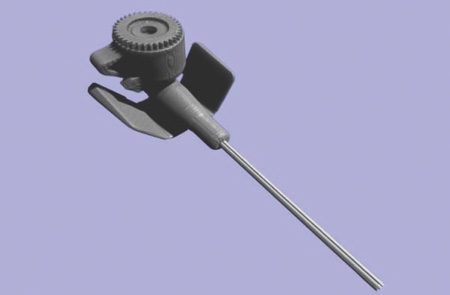
Figure 3: Reconstruction of a cannula (above), component part of cannula digitally extracted from the reconstruction data (below)
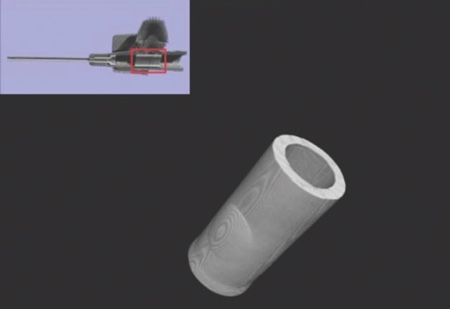
The third example involved investigation of leakage from a cannula. X-ray microtomography revealed a fitting problem of an internal component (Figure 3), which caused the medical drip solution to escape via the syringe connector. X-ray microtomography is uniquely able to provide this internal investigation and to identify faults in situ that would have been impossible to identify had the device been dismantled to investigate individual components.
In conclusion, while the 2-D images shown here can give only an indication of the 3-D detail afforded by X-ray micro-tomography, anyone familiar with the hospital CAT scan will immediately recognise the benefit of imaging the entirety of a sample rather than just a few sections. It means that important details are not overlooked and rather than inferring the whole picture from a few carefully selected images, one simply sees the whole picture.
Whether looking at the intended microstructural features that explain product performance or unexpected features, such as foreign bodies or microstructural defects, the technique can provide lots of useful information. In some cases, perhaps where packaging cannot be opened, or where foreign bodies should not be removed, it offers a unique and perfect solution for investigating an issue and is a powerful addition to the scientist’s armoury.




